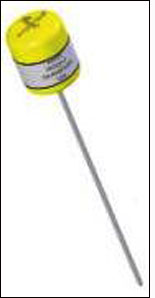May 27, 2011Monitoring meat temperatures within industrial ovens—some large enough to hold tens of thousands of pounds of chicken, turkey, beef or ham—can be a tricky affair. Workers can either insert cabled probes into a piece of meat to track its temperature as it cooks and cools, or they can employ standalone non-cabled probes that must be checked manually by opening an oven door and reading the temperature gauges within. Alkar, a cooking and chilling equipment firm, is offering an alternative method with a wireless probe provided by Matrix Product Development (Matrix PD). Thanks to RFID technology, the probe can move down a conveyor without the restriction of cables, allowing temperature data to be sent automatically to a computer that controls the oven, without requiring staff members to open the door.
Since its launch two years ago, the system, known as Wyze-Temp, has enabled food companies to reduce the amount of waste they produce, by ensuring that meat need not be thrown out as a result of an incorrect temperature that remained undetected until it was too late to rectify. Such a failure might have occurred if employees had been using a manual temperature-tracking process, and simply neglected to take a reading soon enough after a temperature had become too warm or cool. The RFID system also reduces the amount of labor required compared with the manual process of checking the internal temperatures of meat within an oven.
Alkar sells batch and continuous-cooking ovens to companies that cook large quantities of meat (such as deli meats or hot dogs) prior to retail sale. Batch ovens cook meat in a stationary position, and are the size of a typical restaurant oven. Continuous-cooking ovens, on the other hand, transport multiple pieces of meat down a conveyor as they cook, with the meat passing through a variety of heating and cooling zones before the process is complete. The U.S. Department of Agriculture (USDA) closely regulates the preparing of meat, and government inspectors visit cooking sites to ensure the proper temperatures are being maintained. Meat companies typically manage those readings themselves, either via cabled or non-cabled probes, and keep a temperature record for select pieces of meat in each batch, often using probes for up to 14 pieces in a single batch.
Alkar offers cabled probes with its ovens, according to Luke Titel, the company's controls engineering manager, but a number of its customers have sought a wireless solution. With cabled probes, he explains, each temperature sensor is wired to the oven's programmable logic controller (PLC). The cables, however, are cumbersome, and can make it difficult for the probes to reach meat from certain angles, or in some portions of an oven. What's more, cabled probes do not work in continuous-cooking ovens, because the wires restrict the probes from traveling along a conveyor.
When the system is in use, the washable RFID probes are first inserted into the meat. An oven can have between one and six receivers installed on its exterior, wired to antennas located within the unit. As the cooking process proceeds, the probes transmit temperature readings to the antennas at preset intervals. In the case of a continuous-cooking oven, temperature thresholds can be programmed into the system for each reader. For example, one reader could be installed in the oven's cooling section, where temperatures inside the meat would be expected to drop by a specific amount.
In the event that the meat's temperature readings stray above or below an acceptable threshold, the system can trigger an alert, such as an audible alarm, or instruct the PLC to shut down the conveyor. By providing data in real time, and by sounding alerts, the system enables workers to adjust the temperatures in their ovens accordingly, and, in certain cases, to eliminate the need to discard all meat within a particular oven. Since some ovens can cook as much as 20,000 pounds of meat at once, the loss related to such an event would be very expensive.
Approximately five companies are currently utilizing the wireless probes within their continuous-cooking ovens, Titel says, while a dozen or so are using them for batch ovens. Although these firms have not reported statistics regarding their savings, he indicates that users are gaining increased yields (thanks to fewer incidents of discarding entire batches of meat due to incorrect temperatures), as well as a reduction in labor that would otherwise have been required to manually check temperatures on an hourly or more frequent basis.
Alkar's customers, Titel reports, have recently begun showing greater interest in the RFID-enabled system—in part, he says, because it is proving itself. "A lot of people have had bad experiences with new technology [intended to solve temperature-tracking issues]," he states, "so they needed to see this technology prove itself."



